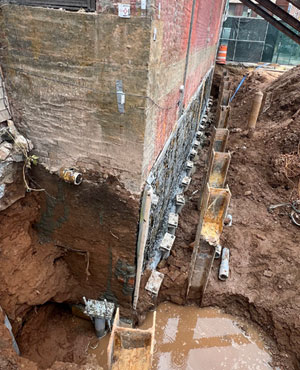A common theme in many of the stories that appear in HPW eNews are circumstances where helicals were used, sometimes in emergency situations, to carry the day when other piling systems proved to be the wrong fit or caused problems that needed fixing. It was this latter situation that recently arose at a new construction site in Jersey City, NJ on a public housing project. Jersey City is bordered by water: the Hackensack River to the West and the Hudson River to the East. Much of the city is built on weak soils, including wetlands reclaimed before the passage in 1970 of the New Jersey “Freshwater Wetlands Protection Act.” Our installers have worked in Jersey City before and a deep foundation is almost always called for, especially for larger/taller structures. (HB6.jpg)
H-piles were originally chosen for the foundation for the new structure, but the installation was agonizingly slow, so the decision was made to pre-auger the H-piles to speed the process. Due to WOH soils and a high-water table, the augured holes collapsed, and, due to the proximity to the adjacent building, less than 3 feet, the aforementioned issues caused it to settle. Danbro encountered a similar situation years ago in Stamford, CT when a washout after a severe storm threatened to undermine a large apartment complex.
Click here to read Stamford Residential Erosion Case History.
 This adjacent existing building was also occupied, so the developer, AM Development, reached out to a local engineering firm, Hudson Engineering, who has a reputation for problem-solving in Jersey City’s challenging environment. Hudson has specified helicals on a number of projects, so they reached out to their go-to installer, Hale Built Group and together came up with a permanent solution. The first step was to install a rack bracing system, using steel girders and carbon fiber strips, to stabilize the four-story brick building. This temporary fix allowed the new construction project to proceed.
This adjacent existing building was also occupied, so the developer, AM Development, reached out to a local engineering firm, Hudson Engineering, who has a reputation for problem-solving in Jersey City’s challenging environment. Hudson has specified helicals on a number of projects, so they reached out to their go-to installer, Hale Built Group and together came up with a permanent solution. The first step was to install a rack bracing system, using steel girders and carbon fiber strips, to stabilize the four-story brick building. This temporary fix allowed the new construction project to proceed.
With the rack bracing in place, careful excavation down below the existing footer of the 50+ year old structure began. Mobilization was difficult, but Hale Built used a mini excavator (Volvo ECR 58) with a seasoned helical pro to guide the installation. The excavation and subsequent installation were hampered by the installed H-piles that were in the way and a high-water table that created a sloppy mess with soil constantly collapsing back into the hole. In addition, the new foundation installation continued making for a busy, crowded site. After about a third of the H-piles had been installed, the contractor switched to micro-piles which went deep, 70+ feet, but caused less site vibration issues. Click here to read Johnson Avenue Underpinning Case History.
Access not only affected the mobilization, but overhead was at issue as well. IDEAL 4.5” pipe piles with 7′ leads (10’ 12’ 14’) and 5′ extensions were installed to 55’ to underpin the structure, arrest the settlement, and achieve the 50-ton capacity. Out of an abundance of caution, grout was added just below the footer to encase the pile/bracket connection to protect and stabilize them further in the questionable soil environment. Our installers will occasionally use concrete in this manner on underpinning projects in situations where the integrity of a footer or corrosion is in question.
 Click here to read Concrete Reinforcement Case History.
Click here to read Concrete Reinforcement Case History.
Hale Built’s specialties include house-lifting and moving, shoring, and complex structural repair. Chuck Tauscher joined Hale Built approximately four years ago, bringing his substantial twenty-five-year commercial experience and extensive helical knowledge to the company. This has helped expand Hale’s reach to Pennsylvania, Delaware, Virginia, and Washington, D.C.
Thippesh Bethur Hanumanthareddy, an engineer with Hudson Engineering who worked on the project, said the emergency underpinning of the old, existing building saved the day and allowed the new construction to stay on pace. “We have used helical piles on a number of projects and have always been very satisfied as they make construction in questionable soil environments possible,” said Thippesh. “We like their versatility as well,” he concluded.




